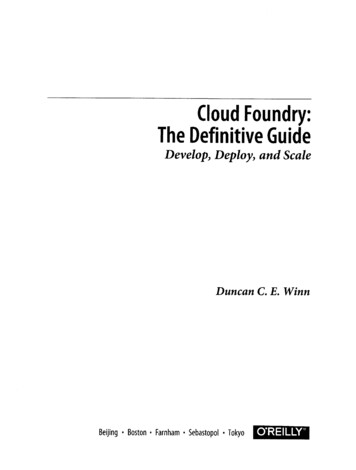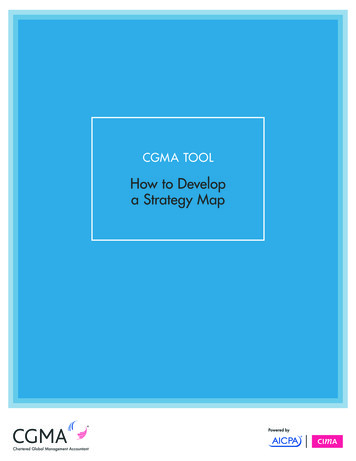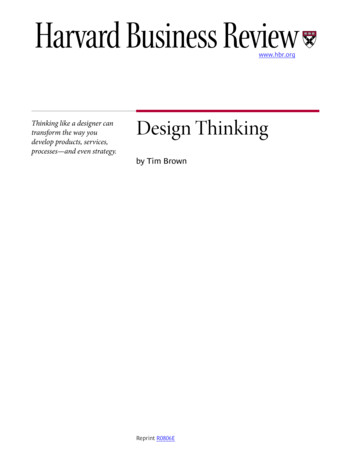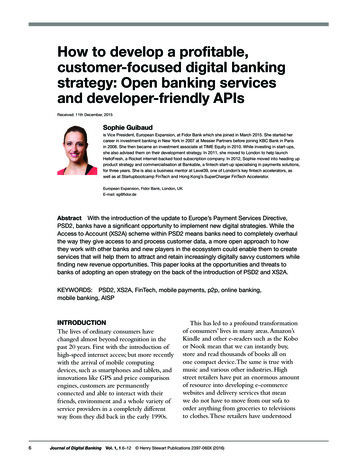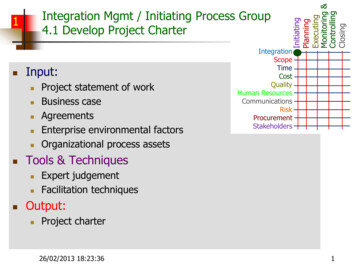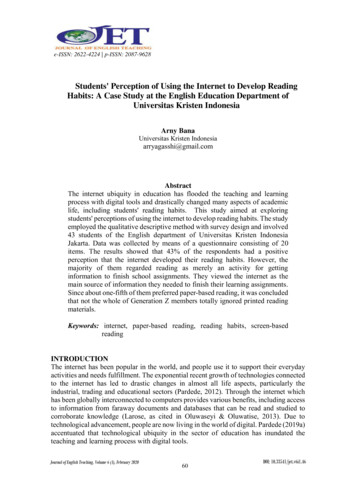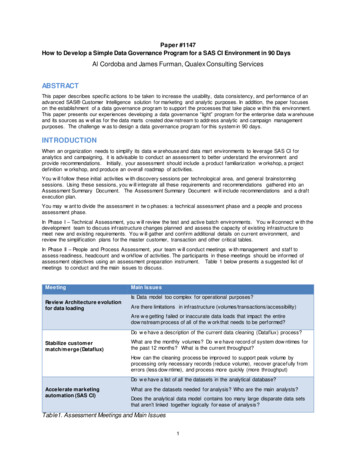
Transcription
Paper #1147How to Develop a Simple Data Governance Program for a SAS CI Environment in 90 DaysAl Cordoba and James Furman, Qualex Consulting ServicesABSTRACTThis paper describes specific actions to be taken to increase the usability, data consistency, and performance of anadvanced SAS Customer Intelligence solution for marketing and analytic purposes. In addition, the paper focuseson the establishment of a data governance program to support the processes that take place w ithin this environment.This paper presents our experiences developing a data governance “light” program for the enterprise data w arehouseand its sources as w ell as for the data marts created dow nstream to addr ess analytic and campaign managementpurposes. The challenge w as to design a data governance program for this system in 90 days.INTRODUCTIONWhen an organization needs to simplify its data w arehouse and data mart environments to leverage SAS CI foranalytics and campaigning, it is advisable to conduct an assessment to better understand the environment andprovide recommendations. Initially, your assessment should include a product familiarization w orkshop, a projectdefinition w orkshop, and produce an overall roadmap of activities.You w ill follow these initial activities w ith discovery sessions per technological area, and general brainstormingsessions. Using these sessions, you w ill integrate all these requirements and recommendations gathered into anAssessment Summary Document. The Assessment Summary Document w ill include recommendations and a draftexecution plan.You may w ant to divide the assessment in tw o phases: a technical assessment phase and a people and processassessment phase.In Phase I – Technical Assessment, you w ill review the test and active batch environments. You w ill connect w ith thedevelopment team to discuss infrastructure changes planned and assess the capacity of existing infrastructure tomeet new and existing requirements. You w ill gather and confirm additional details on current environment, andreview the simplification plans for the master customer, transaction and other critical tables.In Phase II – People and Process Assessment, your team w ill conduct meetings w ith management and staff toassess readiness, headcount and w orkflow of activities. The participants in these meetings should be informed ofassessment objectives using an assessment preparation instrument. Table 1 below presents a suggested list ofmeetings to conduct and the main issues to discuss.MeetingMain IssuesIs Data model too complex for operational purposes?Review Architecture evolutionfor data loadingAre there limitations in infrastructure (volumes/transactions/accessibility)Are w e getting failed or inaccurate data loads that impact the entiredow nstream process of all of the w ork that needs to be performed?Do w e have a description of the current data cleaning (Dataflux) process?Stabilize custom erm atch/m erge (Dataflux)What are the monthly volumes? Do w e have record of system dow ntimes forthe past 12 months? What is the current throughput?How can the cleaning process be improved to support peak volume byprocessing only necessary records (reduce volume), recover gracefully fromerrors (less dow ntime), and process more quickly (more throughput)Do w e have a list of all the datasets in the analytical database?Accelerate m arketingautom ation (SAS CI)What are the datasets needed for analysis? Who are the main analysts?Does the analytical data model contains too many large disparate data setsthat aren’t linked together logically for ease of analysis?Table1. Assessment Meetings and Main Issues1
The assessment should be focused on the main systems needed for marketing analytics and campaigning. At thehighest level, the analytic system needs to accomplish four key objectives:1.2.3.4.Data Loading: Get the correct data and changes from target source systems and efficiently transform andmove it into our analytics ecosystemData Hygiene: Enrich and clean the raw source data efficiently and correctlyAnalytical View s: Format the data in a w ay that is easily usable and consumable by the Analytics teams fortheir business purposesSupport Marketing Efforts: Provide the basis and the tools to support revenue-generating data-drivenmarketing efforts across channelsThe technical assessment should provide information on all the above four processes involved: extraction of datafrom source systems, transformation and cleaning of data; load of clean data into EDW data model; analysis andreporting of data and finally, the use of the data for marketing campaigns.Using this information, five areas should be initially defined and covered:Area I – Data Loading EvolutionArea II – Stabilize the Match/Merge ProcessArea III – Accelerate Marketing AnalyticsArea IV – Improve Campaign PerformanceArea V -- Data GovernanceArea V for Data Governance addresses the fact that, in every organization, the amount and the complexity ofcorporate data in every business unit is grow ing. Data are increasingly shared across corporate and geographicalboundaries. New organizations are being acquired and new sources of data are being added to the Enterprise DataWarehouse (EDW). The success of the EDW w ill ultimately hinge on its ability to maintain a coherent view of data,both now and in the future.Table 2 below show s an information evolution model. We can use this model to identify missing components. Noticethat governance is a critical component at level 3 ALCULTUREPROCESS1.OPERATEManual alApplicationsDepartmentInformationAnalystsOur DepartmentEnterpriseDataGovernanceOfficeAll of usExtendedEnterpriseExtendedGroupOur partners and se3.INTEGRATE4.OPTIMIZ EExtended Enterprise5.INNOVATEAdaptive SystemsSystemsTable 2. Information Evolution ModelFor any company that w ants to improve the quality of its data, it is critical to understand that achieving the highestlevel of data management is an evolutionary governance process. An organization that, a particular time, has adisconnected netw ork filled w ith poor-quality, disjointed data cannot expect to progress to the latter informationevolution stages quickly. There is usually a backlog of activities. The infrastructure and the staff (both from an ITstandpoint as w ell as from corporate leadership and data governance policies) are often simply not in place to allow2
the organization to move quickly from undisciplined to governed.With a focused Data Governance effort, an organization could uncover relationships across tables, databases anddifferent source applications associated w ith a selected key theme. By discovering relationships w ithin and betw eenthe selected data tables, the governance team, led by the data governance manager, can form a complete picture ofthe actual content of the data, simplify projects and enable more consistent results, all w hile providing a faster time tovalue from the team efforts. Upon success, the initial structure and plan should be expanded and maintained as newprocesses, applications and data are introduced to the EDW business.You may find out from the assessment, the system under evaluation, needs remediation regarding POS dataloading, data cleaning, data modeling for marketing and also Data Governance.Figure 1 below depicts a typical SAS CI system.Figure 1. SAS CI Solution OverviewWe find frequently that several tasks need to be addressed to make the system perform w ell. Table 3 below depictshow all the remediation tasks from different areas should w ork together to stabilize a SAS CI system.3
WHAT NEEDS TO BE DONEHOW TO SOLVE THE ISSUEArea I -- The system needs to do a better job ofsourcing business events from across all of our sourcesystems and orchestrating their loading into the EDWSource data properly for the improvements below onAreas II-VArea II -- The Dataflux process needs to be improvedto support peak volume by processing only necessaryrecords (reduce volume), recover smothly from errors(less dow ntime), and process more quickly (morethroughput)Review rules and survival for email, address, phoneand nameArea III -- Work w ith the stakeholders to understandtheir analytical needs and create aggregate data view sthat allow them to easily run analytics and reports tosupport the cadence of the businessCreate 2 data marts Optimize delta jobStabilize Match and Merge processIdentify data quality improvementslongitudinal guest viewsummary tablesAutomate CSV data collectionOptimize segmentation SAS codeArea IV -- Deliver the data to campaign consumers ina w ay that allow s them to focus their efforts onmarketing, not on the intricacies of the dataCreate tw o new CI martsArea V – Improve system governanceDevelop the three main themes of a LIGHT datagovernance framew ork: organizational structure,processes/decisions, and operational planCreate four new Information MapsTable 3. Simplified Remediation Tasks ExampleMETHODSSTANDARD DATA GOVERNANCE PROGRAMThis paper focuses on the development of data governance (Area V in example above). We start by considering astandard data governance program. Typical Data Governance goals include seven components:1.2.3.4.5.6.7.Improve decision-making and coordinationReduce internal issuesProtect data stakeholdersAdopt best practices to address data issuesBuild repeatable information processesReduce costs and increase effectivenessEnsure transparency of processesThe three main key components of a standard data governance are: sponsorship, ow nership and stew ardship.Sponsorship is about active management support from both top-level senior management and management inbusiness units. Successful data governance is achieved through the enterprise-w ide communication of a compellingvision for change, setting performance targets and allocating appropriate resources and budgets. Ow nership is allabout accountability of data quality. Data are created and maintained to enable and support business. Finally,stew ardship includes the ability to understand requirements and needs of data ow ners and translate these needs intodata solutions.4
The Data Governance Institute proposes a ten component framew ork to establish a typical data governance program.Figure 2 below depicts the components.Figure 2. Ten Components of a Data Governance Program DGI . Data Governance InstituteWhen defining a standard data governance program in relation to data quality, w e need to consider w hat data quality(DQ) problem w e are addressing, for instance, quality, integrity, usability, and/or c onsistency of data. We shouldconsider the data quality group or business team that needs better quality data. These groups w ill define the scopeof the data governance project i.e. the EDW group, marketing analytics, marketing, delivery, and CRM. Finally, w econsider w hat data governance can do, besides w ork w ith rules, resolve issues, and provide stakeholder care. Datagovernance should set the direction for Data Quality, monitor data quality, ensure consistent data definitions, identifystakeholders, establish decision rights and clarify accountabilities.The organizational structure f or a Data Governance (DG) program encompasses the groups and individuals involvedin data governance and the relationships among them.A typical data governance structure includes the data governance manager, a data management committee, a datagovernment executive council, and IT personnel. Members of these groups should have the authority to make the keydecisions outlined for the w ork and understand w hen to escalate an issue or development to another group in thedata governance structureA data governance program standard usually includes a Data Governance Office (DGO). Initially, a consultantcould w ork w ith the Data Governance Manager to establish the DGO and develop a w ell-defined set of datastandards to be used to support data quality, including documentation of data domains, data dependencies, source totarget mappings, semantic management, naming conventions, and data-typing. Additionally, the consultant couldw ork to maintain accurate, complete, and timely information about the data marts and w arehouse entities as w ell asprovide feedback to source systems to remedy data quality issues. The organization should implement and adhereto a configuration management plan to include any QA approved updates to the plan.Also a standard governance program should address an Enterprise Performance Life Cycle (EPLC). This is aprocess-driven IT life cycle management approach emphasizing enterprise integration based on development ofsound business and technical requirements. Realizing the benefits of the life cycle methodology, success of theservices model shall depend on the adherence to the organization information technology standards.Finally, in a standard DG program, The Data Governance Office (DGO) develops executive decision supportdashboards and scorecards w hich w ill automatically alert users w hen thresholds are surpassed and action needs tobe taken.5
LIGHT DATA GOVERNANCE PROGRAMFrequently, data governance faces time constraints. This situation makes difficult to develop and implement formalstandard governance processes and instruments. If this is the case, it is possible to create an initial seed, a “light”data governance program in 90 days by focusing the w ork of establishing data governance in three primary phases:1.2.3.Organizational StructureProcesses and Decisions, andOperational PlanTo establish these three primary aspects, w e can start by creating a simple plan to include the follow ing ten Steps fora “Light” Data Governance Development Plan:1.2.3.4.5.6.7.8.9.10.Define DG mission and scopeIdentify initial focus area and metrics for successDefine key data elements and clarify definitionDocument decision rulesFacilitate definition of key accountabilitiesCreate initial data controls using dashboardsIdentify stakeholdersAssist in the formalization of the organizational structureIdentify data stew ardsReview and formalize basic data governance processesYour development plan execution should yield the nine w ork products show n in Table 4 below :WORK PRODUCTDESCRIPTION1.Data Governance PolicyOrganizational Structure2.KPIs definition documentProcesses and Decisions3.Stew ardship PolicyProcesses and Decisions4.EDW Data Dictionary and Metadata FileProcesses and Decisions5.Change Management PolicyProcesses and Decisions6.Data Issue Identification PolicyProcesses and Decisions7.Governance Dashboard PrototypeProcesses and Decisions8.Data Governance ManualProcesses and Decisions9.Data Governance Operational RoadmapOperational PlanTable 4. Data Governance Light Initial Work productsOrganizational Structure PhaseEstablishing a light structure for data governance is a critical initial step. This initial step w ill ensure representativegroups at the leadership and implementation levels have the authority to make collective decisions about theinformation assets and w ill understand their role w ithin the broader DGF effort.A good initial structure may have the follow ing elements:1.2.3.4.Data Governance ManagerIT ResponsibleBusiness Units (BU) Data Stew ards GroupData Governance BoardSome of the activities needed to establish the light organizational structure are:6
1.Confirm the identity of the Data Governance Coordinator/Manager and determine w hich entities (BU) needto be represented in the governance structure.2.Determine w hich roles w ithin BUs needed to be represented at the leadership and implementation levels.3.Agree on purpose, scope, and w ork of data governance, including roles and responsibilities w ithin the effortpresented here.4.Invite the individuals serving in governance roles (not involved) to become a member of either the datapolicy or data management committee.5.Schedule a kickoff meeting to introduce (or reacquaint) participants w ith the purpose, scope, and w ork ofdata governance, including their role and responsibilities w ithin the effort.6.Identify a set of critical KPIs (Data Assets) w ith BU representatives to define an initial data definition scope.Roles and ResponsibilitiesIt is very important to identify roles and responsibilities for all involved in the data governance process. Th ere is oftenlots of fear of the unknow n and information helps everybody feel more comfortable. Mission critical systems such asthe EDW system to collect guest information are crucial to the organization’s continued success in meeting itsmission. These systems need render timely and accurate data w hile meeting the demands of diversified needs ofusers throughout the organization. Additionally, these systems shall result in rich sources of data, w hich provide anintegrated view of the guest. For these critical systems to operate smoothly, it is important to clarify each one’s roleand contribution.BU Data StewardRepresent his/her business unit (BU) at the Data Governance Committee. Work w ith Data Governance Managerand Data Governance Team to develop, implement and manage data strategies that optimize data quality toimprove standardization and business information value derived from enterprise data. Develop business processmodels and documentation related to his/her BU for various data sources coming into Enterprise DataWarehouseEffectively communicate and document business and IT information in line w ith agreed upon data governanceprocess/procedures. Balance technology and business issues as w ell as communicate appropriately w ith bothtechnology and business experts. Analyze and evaluate BU data / information gathered from multiple sourcesand reconcile / address conflicts or business issuesConduct independent analysis and review requirements utilizing know ledge of business systems andrequirements, w ith ability to supply alternative suggestions/improvements to BU data requirements. Manage BUactivities to support data stew ardship of company w ide data from any/all sources into EDW.Manage BU data cleansing, de-duplication and harmonization of data across and w ithin enterprise systems.Identify, analyze, and interpret trends or patterns in complex data sets and develop graphs, reports, andpresentations of resultsConvert business rules from business Subject Matter Experts (SME) into technical rules for data quality analysisand management. Write SQL to query EDW data structure and identify root causes for data issuesWork w ith BU SME to define and execute data quality test scenarios and ensure appropriate end user training.Examine sets of data against criteria for completeness, correctness, and integrityData Governance Manager & IT ResponsibleSome of the tasks w hat should be conducted by the Data Governance manager in conjunction w ith the IT responsiblefor data governance are: Coordinate the Data Governance Committee and develop a data governance communication plan. Communicate betw een Data Governance Committee and Senior Management by creating effectivecommunication pieces: Elevator Speeches, Impact Statements, Presentations, Governance Status Reports,7
Stakeholder emails, and more. Understand and follow organization’s protocols for engaging staff, assigning data governance tasks, andproviding data governance status to management. Promote Data Governance across the organization Develop Information Governance Strategy and Implementation Plan based on governance framew orks Evaluate risks in business processes associated w ith data assets and document process steps, underlyingtechnologies, and inventorying structured and unstructured information assets Categorize and maintain data assets based on its level of criticality and impact to the organization Use governance tools to identify and locate data assets Map and document the flow of critical information (KPI) throughout the information lifecycle Deploy technologies to support
This paper focuses on the development of data governance (Area V in example above). We start by considering a standard data governance program. Typical Data Governance goals include seven components: 1. Improve decision-making and coordination 2. Reduce internal issues 3. Protect data stakeholders 4. Adopt best practices to address data issues 5.File Size: 876KB


